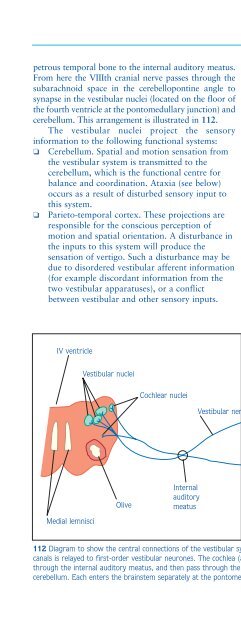You also want an ePaper? Increase the reach of your titles
YUMPU automatically turns print PDFs into web optimized ePapers that Google loves.
Disorders of special senses133petrous temporal bone to the internal auditory meatus.From here the VIIIth cranial nerve passes through thesubarachnoid space in the cerebellopontine angle tosynapse in the vestibular nuclei (located on the floor ofthe fourth ventricle at the pontomedullary junction) andcerebellum. This arrangement is illustrated in 112.The vestibular nuclei project the sensoryinformation to the following functional systems:❏ Cerebellum. Spatial and motion sensation fromthe vestibular system is transmitted to thecerebellum, which is the functional centre forbalance and coordination. Ataxia (see below)occurs as a result of disturbed sensory input tothis system.❏ Parieto-temporal cortex. These projections areresponsible for the conscious perception ofmotion and spatial orientation. A disturbance inthe inputs to this system will produce thesensation of vertigo. Such a disturbance may bedue to disordered vestibular afferent information(for example discordant information from thetwo vestibular apparatuses), or a conflictbetween vestibular and other sensory inputs.❏❏Oculomotor nuclei. These mediate vestibuloocularreflexes: eye movements in the orbit areproduced that are equal in amplitude andopposite in direction to head movements, so thatgaze remains steady. Vestibular nystagmus (seebelow), a physical sign that often accompaniesvertigo, is produced by a disturbance in thisreflex system.Spinal cord. Projections to the spinal cord formthe vestibulo-spinal tract, which mediates thevestibulo-spinal reflexes that assist inmaintaining posture and balance, particularly onthe muscle groups that act against gravity. Thepostural imbalance that often occurs investibular disease is caused by abnormalactivation of these pathways.Traditionally, the anatomical characteristics of thevestibular system have led to the distinction ofperipheral (labyrinthine or vestibular nerve) fromcentral (brainstem or vestibular connections) vertigo.The timing, context, and accompanying symptomatologyusually lead to proper classification into oneIV ventricleSemicircularcanals112Vestibular nucleiCochlear nucleiVestibularganglionVestibular nerveUtricleOliveInternalauditorymeatusCochlear nerveSaculeMedial lemnisciCochlea112 Diagram to show the central connections of the vestibular system. Information from the utricle, saccule, and semicircularcanals is relayed to first-order vestibular neurones. The cochlea (acoustic) and vestibular divisions of cranial nerve VIII travelthrough the internal auditory meatus, and then pass through the subarachnoid space in the angle between the pons andcerebellum. Each enters the brainstem separately at the pontomedullary junction.
















